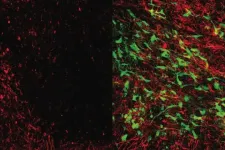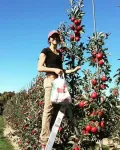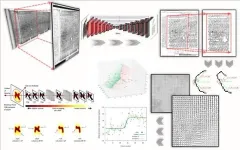(Press-News.org) A one-time injection of an experimental stem cell therapy can repair brain damage and improve memory function in mice with conditions that replicate human strokes and dementia, a new UCLA study finds.
Dementia can arise from multiple conditions, and it is characterized by an array of symptoms including problems with memory, attention, communication and physical coordination. The two most common causes of dementia are Alzheimer's disease and white matter strokes -- small strokes that accumulate in the connecting areas of the brain.
"It's a vicious cycle: The two leading causes of dementia are almost always seen together and each one accelerates the other," said Dr. S. Thomas Carmichael, senior author of the study and interim director of the Eli and Edythe Broad Center of Regenerative Medicine and Stem Cell Research at UCLA.
An estimated 5 million Americans have dementia. "And with the aging population, that number is going to skyrocket," Carmichael said.
Currently, there are no therapies capable of stopping the progression of white matter strokes or enhancing the brain's limited ability to repair itself after they occur. The new study, published in Science Translational Medicine, identifies a cell therapy that can stop the progressive damage caused by the disease and stimulate the brain's own repair processes.
The cells used in the therapy are a specialized type of glial cells, which are cells that surround and support neurons in the central nervous system. Carmichael and his collaborators evaluated the effects of their glial cell therapy by injecting it into the brains of mice with brain damage similar to that seen in humans in the early to middle stages of dementia.
"Upon injection, our cell therapy traveled to damaged areas of the brain and secreted chemicals called growth factors that stimulated the brain's stem cells to launch a repair response," said Dr. Irene Llorente, the paper's first author and an assistant research professor of neurology at the David Geffen School of Medicine at UCLA.
Activating that repair process not only limited the progression of damage, but it also enhanced the formation of new neural connections and increased the production of myelin -- a fatty substance that covers and protects the connections.
"Understanding the role that glia play in repairing white matter damage is a critically important area of research that needs to be explored," said Francesca Bosetti, a program director at the National Institutes of Health's National Institute of Neurological Disorders and Stroke, which supported the study. "These preliminary results suggest that glial cell-based therapies may one day help combat the white matter damage that many stroke and vascular dementia patients suffer every year."
The therapy was developed in collaboration with Bill Lowry, a UCLA professor of molecular, cell and developmental biology. The team used a method, previously discovered by Lowry, for quickly producing large numbers of glial cells by treating human induced pluripotent stem cells with a drug called deferoxamine. Induced pluripotent stem cells are derived from skin or blood cells that have been reprogrammed back to an embryonic stem cell-like state from which scientists can create an unlimited supply of any cell type.
In the future, if the therapy is shown to be safe and effective through clinical trials in humans, the researchers envision it becoming an "off-the-shelf" product, meaning that the cells would be mass manufactured, frozen and shipped to hospitals, where they could be used as a one-time therapy for people with early signs of white matter stroke.
That would set the treatment apart from patient-specific cell therapies, which are created using each individual patient's own cells. While patient-specific cell therapies are appealing because they do not require patients to take drugs to prevent their immune systems from rejecting the transplanted cells, they are also expensive and can take weeks or months to produce.
"The damage from white matter strokes is progressive, so you don't have months to spend producing a treatment for each patient," said Carmichael, who is also chair of neurology at the medical school. "If you can have a treatment that's already in the freezer ready to go during the window of time when it could be most effective, that's a much better option."
The brain is a particularly good target for off-the-shelf cell therapies because immune activity in the brain is highly controlled. That feature, known as immune privilege, allows donor cells or tissues that would be rejected by other parts of the body to survive for prolonged, even indefinite, periods.
Interestingly, the researchers found that even if they eliminated the injected cells a few months after they had been transplanted, the mice's recovery was unaffected. That's because the therapy primarily serves as a wake-up call to stimulate the brain's own repair processes.
"Because the cell therapy is not directly repairing the brain, you don't need to rely on the transplanted cells to persist in order for the treatment to be successful," Carmichael said.
The team is now conducting the additional studies necessary to apply to the Food and Drug Administration for permission to test the therapy in a clinical trial in humans.
INFORMATION:
The research was supported by the California Institute for Regenerative Medicine, the National Institutes of Health, the Dr. Miriam and Sheldon G. Adelson Medical Research Foundation, the Paul G. Allen Family Foundation, the Allen Frontiers Group and a UCLA Broad Stem Cell Research Center Rose Hills Foundation Innovator Grant.
The cell therapy is covered by a patent application filed by the UCLA Technology Development Group on behalf of the Regents of the University of California, with Carmichael, Lowry and Llorente listed as co-inventors. The treatment was used in preclinical tests only and has not been tested in humans or approved by the FDA as safe and effective for use in humans.
We've all heard the news stories of how what you eat can affect your microbiome. Changing your diet can shift your unique microbial fingerprint. This shift can cause a dramatic effect on your health. But what about the microbiome of the plants you eat? Scientists are beginning to see how shifts in plant microbiomes also impact plant health. Unlocking the factors in plant microbial assemblage can lead to innovative and sustainable solutions to increase yield and protect our crops.
In a new study published in the Phytobiomes Journal, "Influence of plant host and organ, management strategy, and spore ...
BUFFALO, N.Y. -- In nature, many molecules possess a property called chirality, which means that they cannot be superimposed on their mirror images (like a left and right hand).
Chirality can influence function, impacting a pharmaceutical or enzyme's effectiveness, for example, or a compound's perceived aroma.
Now, a new study is advancing scientists' understanding of another property tied to chirality: How light interacts with chiral materials under a magnetic field.
Prior research has shown that in such a system, the left- and right-handed forms of a material absorb light differently, in ...
Plenty of people struggle to make sense of a multitude of converging voices in a crowded room. Commonly known as the "cocktail party effect," people with hearing loss find it's especially difficult to understand speech in a noisy environment.
New research suggests that, for some listeners, this may have less to do with actually discerning sounds. Instead, it may be a processing problem in which two ears blend different sounds together - a condition known as binaural pitch fusion.
The research, co-authored by scientists at Oregon Health & Science University and VA Portland Health Care System, was published today in the Journal of the Association for Research ...
When deciding whether to have children, there are many factors to consider: finances, support systems, personal values. For a growing number of people, climate change is also being added to the list of considerations, says a University of Arizona researcher.
Sabrina Helm, an associate professor in the Norton School of Family and Consumer Sciences in the College of Agriculture and Life Sciences, is lead author of a new peer-reviewed study that looks at how climate change is affecting people's decisions about whether to have children.
"For many people, the question of whether to have children or not is one of the biggest they will face in their lives," Helm said. "If you are worried ...
By targeting a receptor in the brains of mice, researchers have successfully altered feeding and anxiety-like behaviors linked to anorexia. Although more work is needed in humans, their study suggests that fine-tuning the receptor's activity could help change feeding habits and promote weight gain in patients with eating disorders. Anorexia and other eating disorders affect at least 28 million Americans and cause more than 10,000 deaths in the U.S. each year, according to the National Association of Anorexia Nervosa and Associated Disorders. Studies have linked anorexia to neurons that bear a protein named AgRP; these neurons reside in an area of the brain ...
Video: https://bit.ly/pelicanflightvideo
It's a common sight: pelicans gliding along the waves, right by the shore. These birds make this kind of surfing look effortless, but actually the physics involved that give them a big boost are not simple.
Researchers at the University of California San Diego have recently developed a theoretical model that describes how the ocean, the wind and the birds in flight interact in a recent paper in Movement Ecology.
UC San Diego mechanical engineering Ph.D. student Ian Stokes and adviser Professor Drew Lucas, of UC San Diego's Department of Mechanical and Aerospace Engineering ...
Like humans, certain plants are treated with antibiotics to ward off pathogens and protect the host. Saving millions, antibiotics are one of the 20th century's greatest scientific discoveries, but repeated use and misuse of these life-saving microbial products can disrupt the human microbiome and can have severe effects on an individual's health. Overuse has led to several microbes developing resistance to the antibiotic, rendering it useless, and created "superbugs" that overpower medication. But do we find that same phenomenon in plants and our food industry?
This was the question Dr. Anna Wallis ...
Handwriting analysis of one of the Dead Sea Scrolls indicates the biblical text was likely written by multiple scribes, who mirrored one another's writing styles.
INFORMATION:
Article Title: Artificial intelligence based writer identification generates new evidence for the unknown scribes of the Dead Sea Scrolls exemplified by the Great Isaiah Scroll (1QIsaa)
Funding: 'Mladen Popovi? Project: The Hands that Wrote the Bible Grant Number: ERC Starting Grant 640497 European Research Council https://erc.europa.eu/ The funders had no role in study design, data collection and analysis, decision to publish, or preparation of the manuscript.'
Competing Interests: The authors have declared that no competing interests exist.
Article URL: https://journals.plos.org/plosone/article?id=10.1371/journal.pone.0249769
...
Weight gain in older age does not appear to preserve cognitive performance, according to study of 58,389 European adults
INFORMATION:
Article Title: Bodyweight change and cognitive performance in the older population
Funding: None of the authors of the manuscript has received specific funding for the work included in this submission. The funders mentioned below did not play any role in the study design, data analysis, decision to publish, or preparation of the manuscript. The SHARE data collection has been primarily funded by the European Commission through FP5 (QLK6-CT-2001-00360), ...
DURHAM, N.C. -- Female baboons may not have bills to pay or deadlines to meet, but their lives are extremely challenging. They face food and water scarcity and must be constantly attuned to predators, illnesses and parasites, all while raising infants and maintaining their social status.
A new study appearing April 21 in Science Advances shows that female baboons with high life-long levels of glucocorticoids, the hormones involved in the 'fight or flight' response, have a greater risk of dying than those with lower levels.
Glucocorticoids are a group of hormones ...




